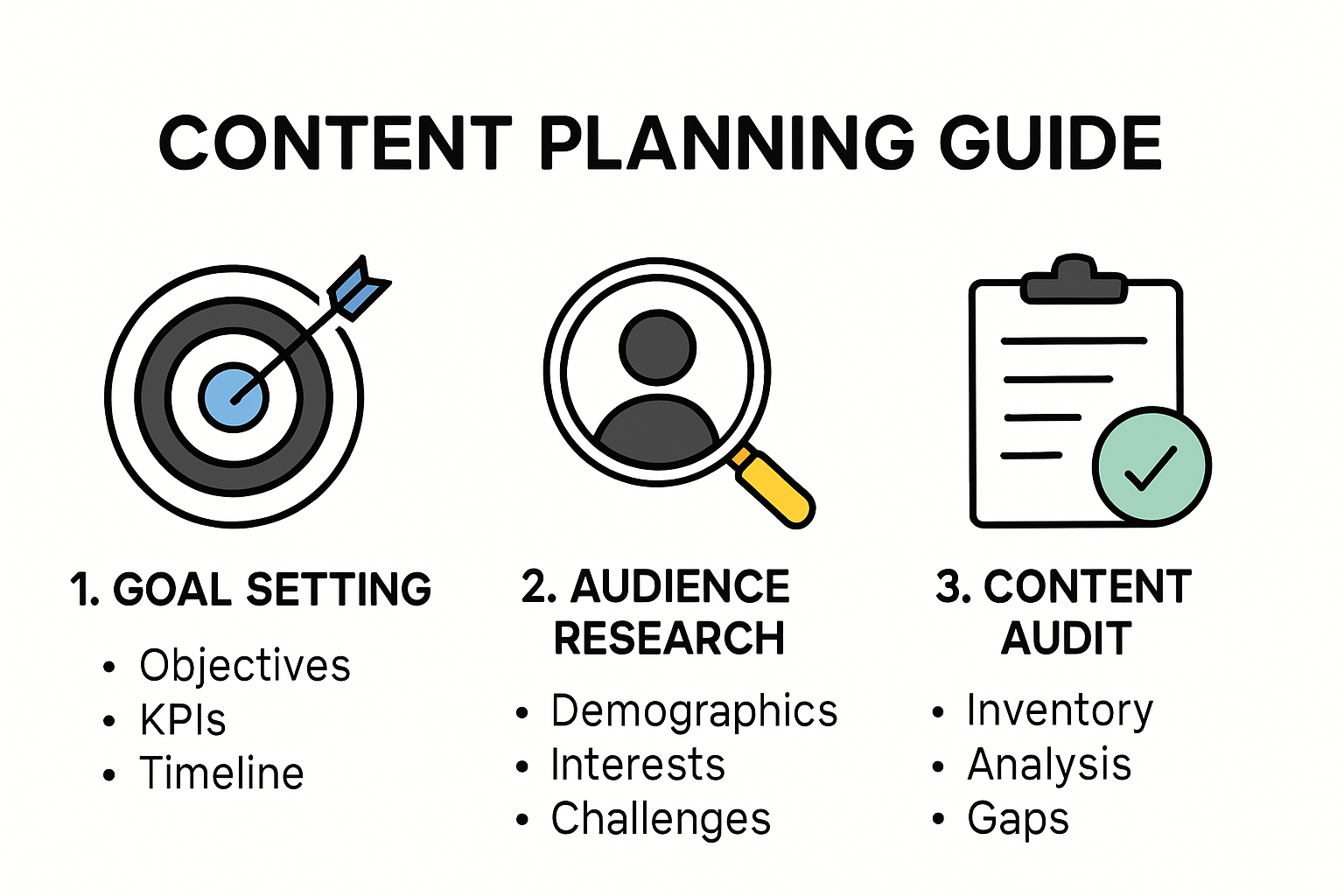Content Planning Guide 2025: Strategies for Growth Success


Content planning can make or break your digital growth in 2025. A staggering organizations that lack a structured content plan can waste up to 35 percent of their annual content budget. Most people focus on creating more content and hope for better results. The real advantage comes from a smarter content strategy that transforms random ideas into measurable business wins.
Table of Contents
- Why You Need A Content Planning Guide
- Steps To Build A Successful Content Plan
- Content Tools And Templates For 2025
- Common Mistakes And How To Avoid Them
Quick Summary
| Takeaway | Explanation |
|---|---|
| Content Planning is Essential | A structured content plan acts as a strategic roadmap, ensuring efficient resource allocation, consistent messaging, and alignment with business goals. |
| Understand Your Audience | Conduct thorough audience research to develop detailed personas, allowing for content that resonates with specific needs and challenges. |
| Regular Content Audits | Perform comprehensive content audits to identify gaps and strengths, enabling the development of a strategic content plan that aligns with audience needs. |
| Continuous Optimization is Key | Implement a dynamic content calendar that allows for regular measurement and adaptation of content strategies based on performance metrics and audience feedback. |
| Avoid Common Mistakes | Be aware of strategic planning errors, quality challenges, and technical mistakes; establish clear objectives and rigorous processes to enhance content effectiveness. |

Why You Need a Content Planning Guide
Content planning is not just a buzzword. It is a strategic approach that transforms how businesses create, manage, and distribute content. Without a solid content planning guide, organizations risk wasting resources, missing audience connections, and falling behind competitors.
The Strategic Importance of Content Planning
A content planning guide serves as a critical roadmap for digital success. The UK Department for Education emphasizes that an effective content strategy ensures efficient planning, collaboration, and measurable outcomes. It helps organizations create content that directly meets user needs and aligns with business goals.
Companies without a structured content plan often experience several challenges. Random content creation leads to inconsistent messaging, fragmented audience experiences, and inefficient resource allocation. A comprehensive content planning guide eliminates these problems by providing a clear framework for content development.
Optimizing User Experience Through Strategic Content
The University of Minnesota highlights that content is fundamental to creating an exceptional user experience. A well-developed content planning guide helps organizations:- Strategic Alignment: Ensure content consistently reflects brand voice and objectives
- Audience Targeting: Create content that resonates with specific audience segments
- Resource Efficiency: Reduce time and effort spent on unproductive content creation
Long-Term Benefits of Structured Content Planning
The University of Wisconsin-Madison notes that strategic content planning delivers significant long-term advantages. By establishing a strong content foundation, businesses can avoid duplicate content, streamline production processes, and create more meaningful audience connections.A robust content planning guide transforms content from a random activity into a strategic business function. It provides clear guidelines for content creation, helps track performance, and ensures that every piece of content serves a specific purpose. Whether you are a small business or a large enterprise, investing in a comprehensive content planning approach is no longer optional - it is essential for digital success.
Understanding and implementing a content planning guide will position your organization to create more impactful, targeted, and effective content that drives real business results.
Here is a summary table highlighting the key benefits of structured content planning discussed in this section:
| Benefit | Description |
|---|---|
| Strategic Alignment | Ensures content reflects brand voice and business objectives |
| Audience Targeting | Allows content to resonate with specific audience segments |
| Resource Efficiency | Reduces wasted time and resources on unproductive content creation |
| Consistent Messaging | Prevents inconsistent communication across platforms |
| Streamlined Production Processes | Avoids duplication and optimizes workflow efficiency |
| Measurable Outcomes | Facilitates tracking of content performance and aligns with business goals |
Steps to Build a Successful Content Plan
Building a successful content plan requires strategic thinking, careful research, and a systematic approach. A well-crafted content strategy transforms random content creation into a purposeful, goal-driven process that delivers measurable results.
Define Clear Goals and Audience Understanding
Coursera recommends starting with two critical steps: defining your goals and researching your target audience. Understanding what you want to achieve helps create focused, intentional content. Texas State University emphasizes that goals should be specific, measurable, and aligned with broader business objectives.Audience research goes beyond basic demographics. You need to understand their pain points, preferences, communication styles, and digital behaviors. Create detailed audience personas that capture motivations, challenges, and content consumption habits. This deep understanding ensures your content speaks directly to their needs and interests.
Content Audit and Strategic Planning

Before creating new content, conduct a comprehensive content audit. The University of Minnesota suggests analyzing existing content to identify gaps, strengths, and opportunities. Review:
- Content Performance: Evaluate which pieces generate engagement
- Content Relevance: Check if current content matches audience needs
- Content Gaps: Identify topics or formats not currently addressed
Once you understand your existing content landscape, develop a strategic content plan. This involves selecting appropriate content types, determining publication frequencies, and mapping content to different stages of the customer journey.
Implementation and Continuous Optimization
Successful content planning requires a robust implementation framework. Create a content calendar that outlines:
- Specific content topics
- Target publication dates
- Responsible team members
- Distribution channels
Implementation is not a one-time event but an ongoing process. Regularly measure content performance using key metrics like engagement rates, conversion rates, and audience feedback. Be prepared to adapt your strategy based on these insights.
Remember that a content plan is a living document. The digital landscape evolves rapidly, and your content strategy must remain flexible and responsive to changing audience needs and market dynamics.
By following these systematic steps, you transform content from a random activity into a strategic business tool that drives engagement, builds brand authority, and supports your overall business objectives.
Below is a table summarizing the main steps to build a successful content plan, along with their key actions:
| Step | Key Actions |
|---|---|
| Define Clear Goals | Set specific, measurable objectives aligned with business needs |
| Understand Your Audience | Conduct research, create detailed personas |
| Content Audit | Review existing content performance, relevance, and gaps |
| Strategic Plan Development | Map content types, frequencies, and customer journey stages |
| Implementation | Develop a content calendar, assign responsibilities, set channels |
| Continuous Optimization | Measure results, collect feedback, adapt strategy as needed |
Content Tools and Templates for 2025
The content planning landscape continues to evolve rapidly, with emerging tools and templates designed to streamline strategic content development. As we approach 2025, professionals need sophisticated resources that blend technology, efficiency, and strategic insight.
Advanced Content Planning Templates
The South Carolina Department of Education provides insights into comprehensive planning resources that can be adapted for content strategy. Modern content planning templates now incorporate multiple dimensions beyond traditional spreadsheets, including:- Strategic Alignment: Mapping content to specific business objectives
- Performance Tracking: Built-in metrics and KPI measurement capabilities
- Workflow Integration: Seamless collaboration features
These templates serve as dynamic frameworks that transform static planning documents into interactive strategic tools. They enable content creators to visualize entire content ecosystems, track progress, and make data-driven adjustments in real-time.
AI-Powered Content Planning Technologies
Cutting-edge research from EduPlanner demonstrates how large language models can generate intelligent, customized content planning systems. These AI-driven tools provide unprecedented capabilities, including:- Automated content gap analysis
- Predictive performance modeling
- Personalized content recommendation engines
AI technologies are revolutionizing content planning by providing granular insights and predictive capabilities that were previously impossible. They can analyze vast amounts of data, identify emerging trends, and suggest optimized content strategies tailored to specific audience segments.
Integrated Content Management Ecosystems
Modern content planning tools are no longer standalone applications. They represent comprehensive ecosystems that integrate multiple functions, including:
- Content creation
- SEO optimization
- Performance analytics
- Collaboration management
- Distribution channel coordination
The most effective tools in 2025 will offer seamless integration, allowing content teams to move from strategy to execution with minimal friction. They will provide real-time insights, automate repetitive tasks, and enable more strategic, creative content development.
As technology continues to advance, content planning tools will become increasingly intelligent, adaptive, and user-friendly. Organizations that invest in sophisticated, AI-enhanced planning resources will gain significant competitive advantages in creating targeted, high-performance content strategies.
Common Mistakes and How to Avoid Them
Content planning is a nuanced process where even experienced professionals can stumble. Understanding common pitfalls and developing strategies to avoid them can significantly improve your content strategy's effectiveness and impact.
Strategic Planning Errors
Oregon State University highlights the importance of recognizing and mitigating strategic errors. One of the most frequent mistakes is creating content without a clear, defined purpose. This often results in scattered, ineffective content that fails to engage the target audience.To avoid this, always begin with explicit objectives. Ask yourself: What specific goal does this content serve? Who exactly are we trying to reach? What action do we want the audience to take? By establishing clear parameters, you create a focused content strategy that delivers tangible results.
Content Creation and Quality Challenges
Paperpal identifies several critical content creation mistakes that can undermine your strategy. These include:- Inconsistent Messaging: Varying tone and brand voice across different content pieces
- Lack of Original Insight: Rehashing existing content without adding unique value
- Poor Research and Validation: Using outdated or unverified information
Overcoming these challenges requires a disciplined approach. Develop comprehensive content guidelines that standardize your brand voice. Invest time in original research and provide unique perspectives that differentiate your content from competitors. Regularly update and fact-check your content to maintain credibility and relevance.
Technical and Structural Content Mistakes
Best Edit & Proof emphasizes the importance of technical precision in content creation. Common technical mistakes include:- Neglecting SEO best practices
- Failing to optimize content for different platforms
- Inadequate proofreading and editing
Addressing these issues requires a multi-faceted approach. Implement rigorous editorial processes that include multiple review stages. Use SEO tools to ensure your content is optimized for search engines. Create content with platform-specific considerations, understanding that what works on a blog might not translate directly to social media.
Successful content planning is about more than avoiding mistakes. It is about creating a proactive, strategic approach that anticipates potential challenges and builds robust systems to address them. By understanding common pitfalls and developing targeted strategies to overcome them, you can create a content planning process that consistently delivers high-quality, impactful content.
Remember, content planning is an iterative process. Be willing to learn, adapt, and continuously refine your approach based on performance data and audience feedback.
Frequently Asked Questions
What is content planning and why is it important?
Content planning is a strategic approach that involves organizing and managing content creation and distribution to align with business goals. It is important because it ensures efficient resource allocation, consistency in messaging, and improved user experience, ultimately driving measurable business results.
How can I define clear goals for my content strategy?
To define clear goals for your content strategy, start by determining specific, measurable objectives that align with your overall business goals. Use the SMART criteria: Specific, Measurable, Achievable, Relevant, and Time-bound to refine your objectives.
What tools can I use for content planning in 2025?
In 2025, consider using advanced content planning templates, AI-powered content planning technologies, and integrated content management ecosystems. These tools can streamline your strategy, provide valuable insights, and enhance collaboration among team members.
What are common mistakes to avoid in content planning?
Common mistakes in content planning include creating content without a clear purpose, inconsistent messaging, and neglecting SEO best practices. To avoid these pitfalls, establish clear objectives, maintain consistent branding, and optimize your content for search engines.
Transform Your Content Planning With Seamless AI-Powered Execution
Are you tired of seeing your carefully crafted content strategy fall flat due to slow execution, inconsistent quality, or wasted resources? The article "Content Planning Guide 2025: Strategies for Growth Success" highlights how random content creation, lack of audience targeting, and inefficient workflows can drain your budget and your team's morale. Imagine channeling all that strategic planning into measurable online growth, without the stress of micromanaging every blog post or SEO update.

Take action today and ensure that your structured content plan is more than just a document on paper. See how BabyLoveGrowth.ai helps you bridge the gap from intent to impact with just three steps. Enjoy automated SEO content generation tailored to your goals, a custom 30-day content strategy based on in-depth business analysis, and hands-free publishing designed for real results. Discover how BabyLoveGrowth.ai empowers you to launch your strategy and achieve growth success now. Ready to stop wasting time and start seeing real performance? Visit BabyLoveGrowth.ai and unlock content excellence today.
Recommended
Smart SEO,
Faster Growth!
Most Read Articles

Generative Engine Optimization (GEO)
Learn how Generative Engine Optimization (GEO) helps your content rank in AI search engines like ChatGPT and Google AI. This comprehensive guide explains the differences between SEO and GEO, why it matters for your business, and practical steps to implement GEO strategies for better visibility in AI-generated responses.

Track LLM Traffic in Google Analytics 4 (GA4)
Learn how to track and analyze traffic from AI sources like ChatGPT, Claude, Perplexity, and Google Gemini in Google Analytics 4. This step-by-step guide shows you how to set up custom filters to monitor AI-driven traffic and make data-driven decisions for your content strategy.

How to Humanize AI Text with Instructions
Learn practical techniques to make AI-generated content sound more natural and human. This guide covers active voice, direct addressing, concise writing, and other proven strategies to transform robotic text into engaging content.

Open AI Revenue and Statistics (2024)
Comprehensive analysis of OpenAI financial performance, user engagement, and market position in 2023. Discover key statistics including $20B valuation, $1B projected revenue, and 100M+ monthly active users.